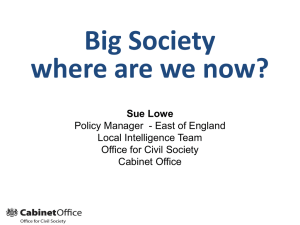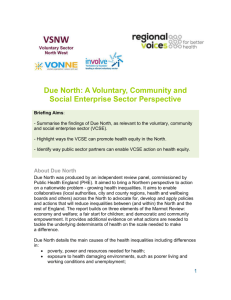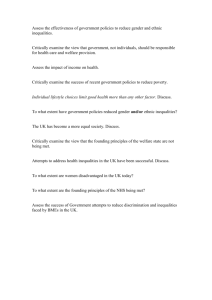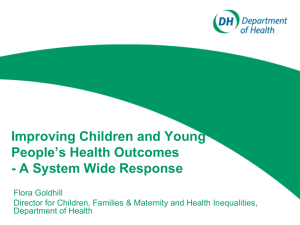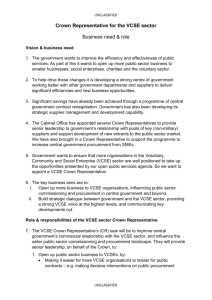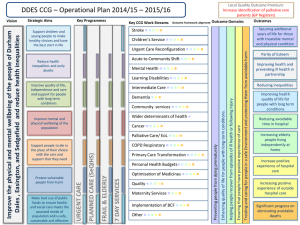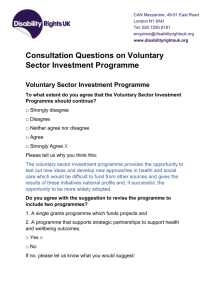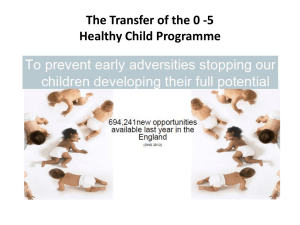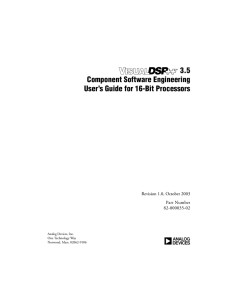Due North- A VCSE Perspective - Briefing
advertisement
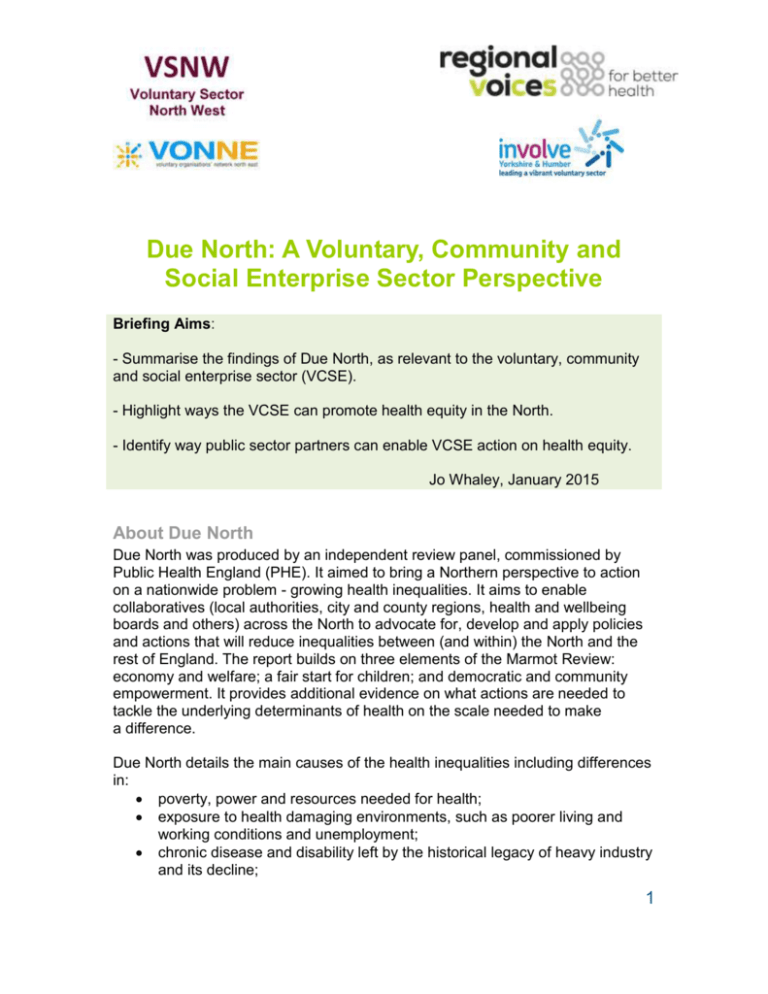
Due North: A Voluntary, Community and Social Enterprise Sector Perspective Briefing Aims: - Summarise the findings of Due North, as relevant to the voluntary, community and social enterprise sector (VCSE). - Highlight ways the VCSE can promote health equity in the North. - Identify way public sector partners can enable VCSE action on health equity. Jo Whaley, January 2015 About Due North Due North was produced by an independent review panel, commissioned by Public Health England (PHE). It aimed to bring a Northern perspective to action on a nationwide problem - growing health inequalities. It aims to enable collaboratives (local authorities, city and county regions, health and wellbeing boards and others) across the North to advocate for, develop and apply policies and actions that will reduce inequalities between (and within) the North and the rest of England. The report builds on three elements of the Marmot Review: economy and welfare; a fair start for children; and democratic and community empowerment. It provides additional evidence on what actions are needed to tackle the underlying determinants of health on the scale needed to make a difference. Due North details the main causes of the health inequalities including differences in: poverty, power and resources needed for health; exposure to health damaging environments, such as poorer living and working conditions and unemployment; chronic disease and disability left by the historical legacy of heavy industry and its decline; 1 opportunities to enjoy positive health factors and protective conditions that help maintain health, such as good quality early years education; economic and food security, control over decisions that impact your life; social support and feeling part of the society in which you live. Due North notes that health inequality has been further exacerbated by cuts in public spending and there is a grave danger that steps towards economic recovery continue to widen health inequalities, especially along the North-South divide. The report sets out a series of recommendations, aimed separately at northern agencies (including the VCSE) and central government. The four high level recommendations are: 1. tackle poverty and economic inequality within the North and between the North and the rest of England 2. promote healthy development in early childhood 3. share power over resources and increase the influence that the public has on how resources are used to improve the determinants of health 4. strengthen the role of the health sector in promoting health equity The aim of this briefing is to pull out key aspects of how the VCSE can support the recommendations and how public sector partners can enable VCSE action against health inequalities. Potential actions for the VCSE sector to address health inequity Many of the practical solutions proposed in Due North are bread and butter to the VCSE sector (e.g. promoting credit unions, giving benefit advice, supporting healthy child development, empowering involvement in democratic processes such as participatory budgeting). Much of the sector's work is with the poorest communities - those experiencing the worst health outcomes. The next section outlines possible actions VCSE organisations could take to impact on health inequalities, particularly between the North and South. Some are taken directly from the Due North report, others are extrapolations based on Regional Voices' intelligence from the VCSE sector. As service providers 1. Deliver place-based services which communities can shape. 2. Re-energise VCSE sector involvement in delivering holistic employment support with an emphasis on the person and on building confidence, wellbeing and opportunities. 3. Share and scale up good practice which makes a difference - work with public health partners to demonstrate impact. 2 As local partners 4. Contribute to local intelligence about health inequity, and how this intelligence can be 'translated' into local action. 5. Co-design place-based services, and support communities to work with policy makers and funders to shape change. 6. Support the development of intelligent local investment strategies which build connections (networks) and community capacity (knowledge, opportunities, motivation) especially with regard to early years' public service delivery outcomes. 7. When involved in local enterprise partnerships and combined authority governance ensure that reducing economic and health inequalities and promoting health and wellbeing are central objectives in economic development strategies. 8. Provide expertise on working and make links with specific communities and equalities groups - make sure no-one gets left behind. As employers 9. Become Living Wage employers. 10. Ensure that volunteering is not used as a form of job substitution. 11. Support the development of an effective VCSE sector workforce strategy e.g. in a developing early years' delivery landscape and around Making Every Contact Count. As lobbyers/campaigners 12. Use the Social Value Act to lobby for maximum social value from public sector spend, including funding of local VCSE organisations and investing in local services. 13. Advocate on behalf of communities and equalities groups to make sure noone gets left behind as economy begins to grow. For Healthwatch organisations Due North made several recommendations specifically for Healthwatch, aiming to increase its role in monitoring progress against health inequality: 14. Government should invest in and expand the role of Healthwatch as an independent community led advocate that can hold government and public services to account for action and progress on health inequalities. 15. PHE could work with Healthwatch and health and wellbeing boards across the North of England to develop community-led systems for health equity monitoring and accountability. 16. Healthwatch could be positioned to work with community groups and PHE to develop measures of progress on health inequalities at the national and local authority levels. They could involve communities in tracking progress both in terms of the community as a whole and inequalities within and between communities. 3 National organisations may also wish to 17. Use Due North findings to influence national bodies (grant makers, policy makers etc) to address structural causes of health inequalities. 18. Apportion activity relevant to geographic need. Support for VCSE to impact on health inequalities 19. Enable development of relationships between VCSE organisations and public sector partners (public health teams, centres and PHE nationally, CCGs, NHS England area teams, local authorities, health and wellbeing boards etc) to codesign solutions to health inequalities. 20. Support VCSE organisations to use intelligence, including that held by public health and NHS partners, to help make the case for interventions (to enable commissioning and input into JSNAs) and support with measuring impact (see Comparing Apples with Oranges - How to make better use of voluntary and community sector evidence to improve health outcomes). 21. Invest in the local VCSE organisations. "Spot purchasing" rather than "core funding" leaves organisations financially vulnerable; particularly smaller, trusted, organisations, which are most able to address specific inequalities (in geographic communities and communities of interest). 22. Invest in VCSE infrastructure organisations (also called umbrella organisations or support and development organisations) which enable smaller organisations to work more strategically and can help public health and the NHS to engage with the VCSE sector and the communities they serve. 23. Commissioners should be aware of barriers to VCSE involvement in commissioning and work with the sector (locally, regionally and nationally) to help to overcome the barriers (see "The Voluntary and Community Sector and Localised Health Commissioning") 24. Local enterprise partnerships and combined authorities governance could benefit from working closely with, and investing in, the VCSE sector to ensure that reducing economic and health inequalities, and promoting health and wellbeing, are central objectives in economic development strategies (see the Local Enterprise Partnership Engagement Project). What do you think? Are the recommendations right? What would help your organisation address health inequalities? Let Jo.Whaley@regionalvoices.org know if you have anything to add. Links to further information Due North report (links to full report and executive summary) 4 PHE interim response to Due North and slide set on Health Equity North Local action on health inequalities: evidence papers (Public Health England and Institute of Health Equity). These resources translate the Marmot Review recommendations into practical, evidence based actions. PHE Longer Lives website data which demonstrates the scale of the health issues and health inequalities impacting on the population of the North of England. Comparing Apples with Oranges- How to make better use of voluntary and community sector evidence to improve health outcomes (NHS Confederation, Regional Voices and LGA). Regional Voices connects voluntary and community organisations with government, through nine regional networks, to inform and influence policy at local, regional and national levels. Regional Voices is a Strategic Partner to the Department of Health, NHS England and Public Health England. To find out more about Regional Voices' work in health, wellbeing and care go to Regional Voices' website. Follow us on twitter @regionalvoice If you require this information in an alternative format or further information email or call: contact@regionalvoices.org 0113 394 2300 5
